Symbol Anticodon_2 InterPro IPR013155 SUPERFAMILY 1ivs | Pfam PF08264 SCOP 1ivs Pfam structures | |
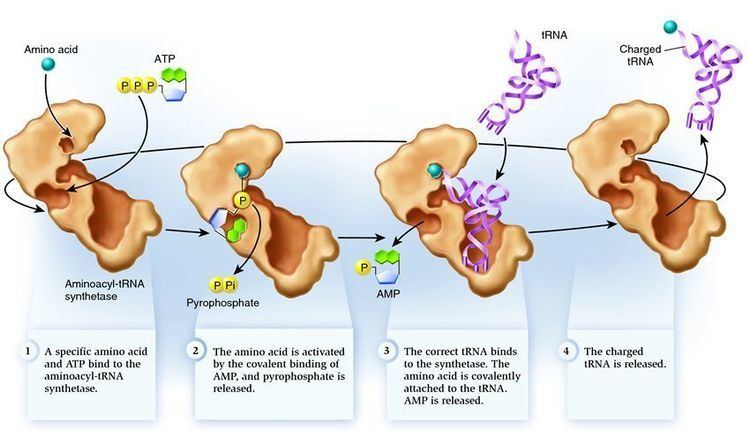 | ||
An aminoacyl tRNA synthetase (aaRS) is an enzyme that attaches the appropriate amino acid onto its tRNA. It does so by catalyzing the esterification of a specific cognate amino acid or its precursor to one of all its compatible cognate tRNAs to form an aminoacyl-tRNA. In humans, the 20 different types of aa-tRNA are made by the 20 different aminoacyl-tRNA synthetases, one for each amino acid of the genetic code.
Contents
- Translation part 3 of 8 aminoacyl trna synthetase reaction
- Mechanism
- Classes
- Structures
- Evolution
- Application in biotechnology
- Prediction Servers
- References

This is sometimes called "charging" or "loading" the tRNA with the amino acid. Once the tRNA is charged, a ribosome can transfer the amino acid from the tRNA onto a growing peptide, according to the genetic code. Aminoacyl tRNA therefore plays an important role in DNA translation, the expression of genes to create proteins.
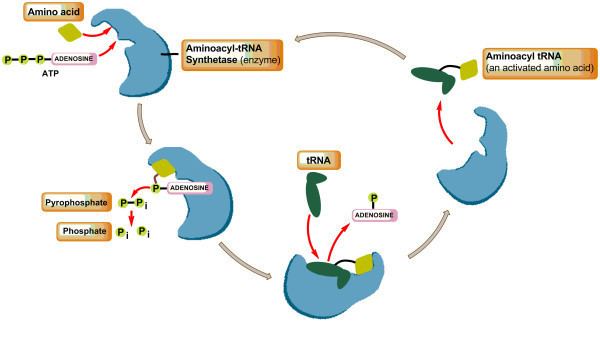
Translation part 3 of 8 aminoacyl trna synthetase reaction
Mechanism

The synthetase first binds ATP and the corresponding amino acid (or its precursor) to form an aminoacyl-adenylate, releasing inorganic pyrophosphate (PPi). The adenylate-aaRS complex then binds the appropriate tRNA molecule's D arm, and the amino acid is transferred from the aa-AMP to either the 2'- or the 3'-OH of the last tRNA nucleotide (A76) at the 3'-end.
The mechanism can be summarized in the following reaction series:
- Amino Acid + ATP → Aminoacyl-AMP + PPi
- Aminoacyl-AMP + tRNA → Aminoacyl-tRNA + AMP
Summing the reactions, the highly exergonic overall reaction is as follows:
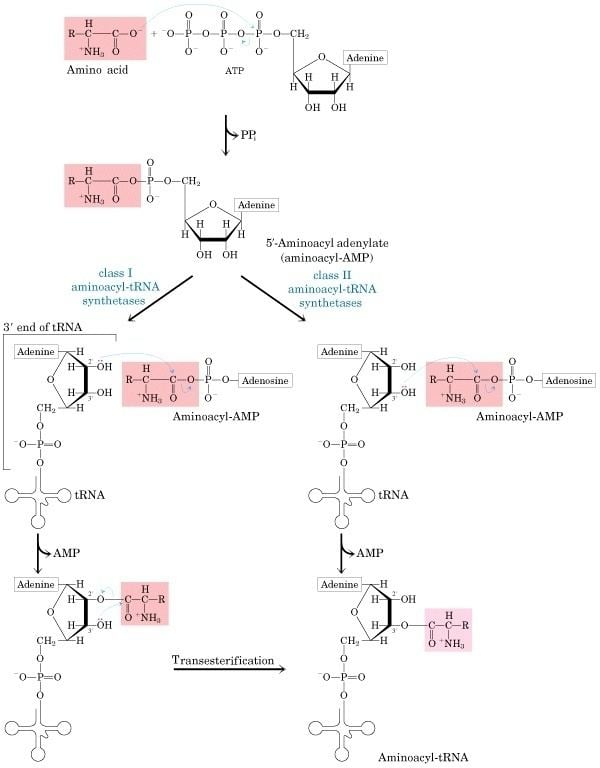
Some synthetases also mediate a editing reaction to ensure high fidelity of tRNA charging. If the incorrect tRNA is added (aka. the tRNA is found to be improperly charged), the aminoacyl-tRNA bond is hydrolyzed. This can happen when two amino acids have different properties even if they have similar shapes—as is the case with Valine and Threonine.
Classes
There are two classes of aminoacyl tRNA synthetase:
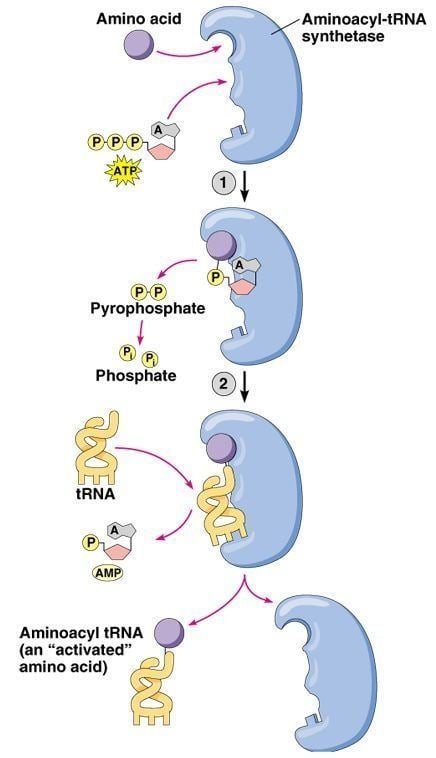
The amino acids are attached to the hydroxyl (-OH) group of the adenosine via the carboxyl (-COOH) group.
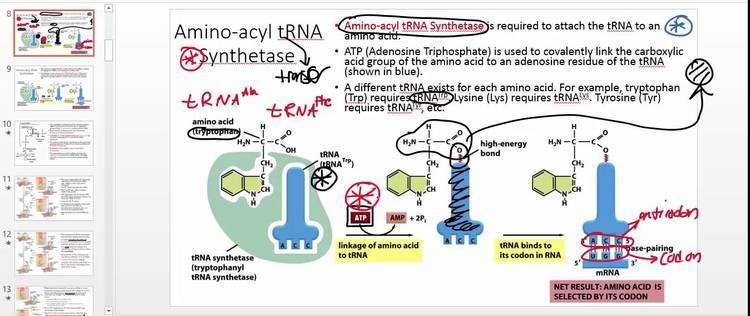
Regardless of where the aminoacyl is initially attached to the nucleotide, the 2'-O-aminoacyl-tRNA will ultimately migrate to the 3' position via transesterification.
Structures
Both classes of aminoacyl-tRNA synthetases are multidomain proteins. In a typical scenario, an aaRS consists of a catalytic domain (where both the above reactions take place) and an anticodon binding domain (which interacts mostly with the anticodon region of the tRNA and ensures binding of the correct tRNA to the amino acid). In addition, some aaRSs have additional RNA binding domains and editing domains that cleave incorrectly paired aminoacyl-tRNA molecules.
The catalytic domains of all the aaRSs of a given class are found to be homologous to one another, whereas class I and class II aaRSs are unrelated to one another. The class I aaRSs have the ubiquitous Rossmann fold and have the parallel beta-strands architecture, whereas the class II aaRSs have a unique fold made up of antiparallel beta-strands.
The alpha helical anticodon binding domain of Arginyl, Glycyl and Cysteinyl-tRNA synthetases is known as the DALR domain after characteristic conserved amino acids.
Evolution
Most of the aaRSs of a given specificity are evolutionarily closer to one another than to aaRSs of another specificity. However, AsnRS and GlnRS group within AspRS and GluRS, respectively. Most of the aaRSs of a given specificity also belong to a single class. However, there are two distinct versions of the LysRS - one belonging to the class I family and the other belonging to the class II family.
In addition, the molecular phylogenies of aaRSs are often not consistent with accepted organismal phylogenies. That is, they violate the so-called canonical phylogenetic pattern shown by most other enzymes for the three domains of life - Archaea, Bacteria, and Eukarya. Furthermore, the phylogenies inferred for aaRSs of different amino acids often do not agree with one another. These are two clear indications that horizontal transfer has occurred several times during the evolutionary history of aaRSs.
Application in biotechnology
In some of the aminoacyl tRNA synthetases, the cavity that holds the amino acid can be mutated and modified to carry unnatural amino acids synthesized in the lab, and to attach them to specific tRNAs. This expands the genetic code, beyond the twenty canonical amino acids found in nature, to include an unnatural amino acid as well. The unnatural amino acid is coded by a nonsense (TAG, TGA, TAA), quadruplet, or in some cases a redundant rare codon. The organism that expresses the mutant synthetase can then be genetically programmed to incorporate the unnatural amino acid into any desired position in any protein of interest, allowing biochemists or structural biologists to probe or change the protein's function. For instance, one can start with the gene for a protein that binds a certain sequence of DNA, and, by directing an unnatural amino acid with a reactive side-chain into the binding site, create a new protein that cuts the DNA at the target-sequence, rather than binding it.
By mutating aminoacyl tRNA synthetases, chemists have expanded the genetic codes of various organisms to include lab-synthesized amino acids with all kinds of useful properties: photoreactive, metal-chelating, xenon-chelating, crosslinking, spin-resonant, fluorescent, biotinylated, and redox-active amino acids. Another use is introducing amino acids bearing reactive functional groups for chemically modifying the target protein.
